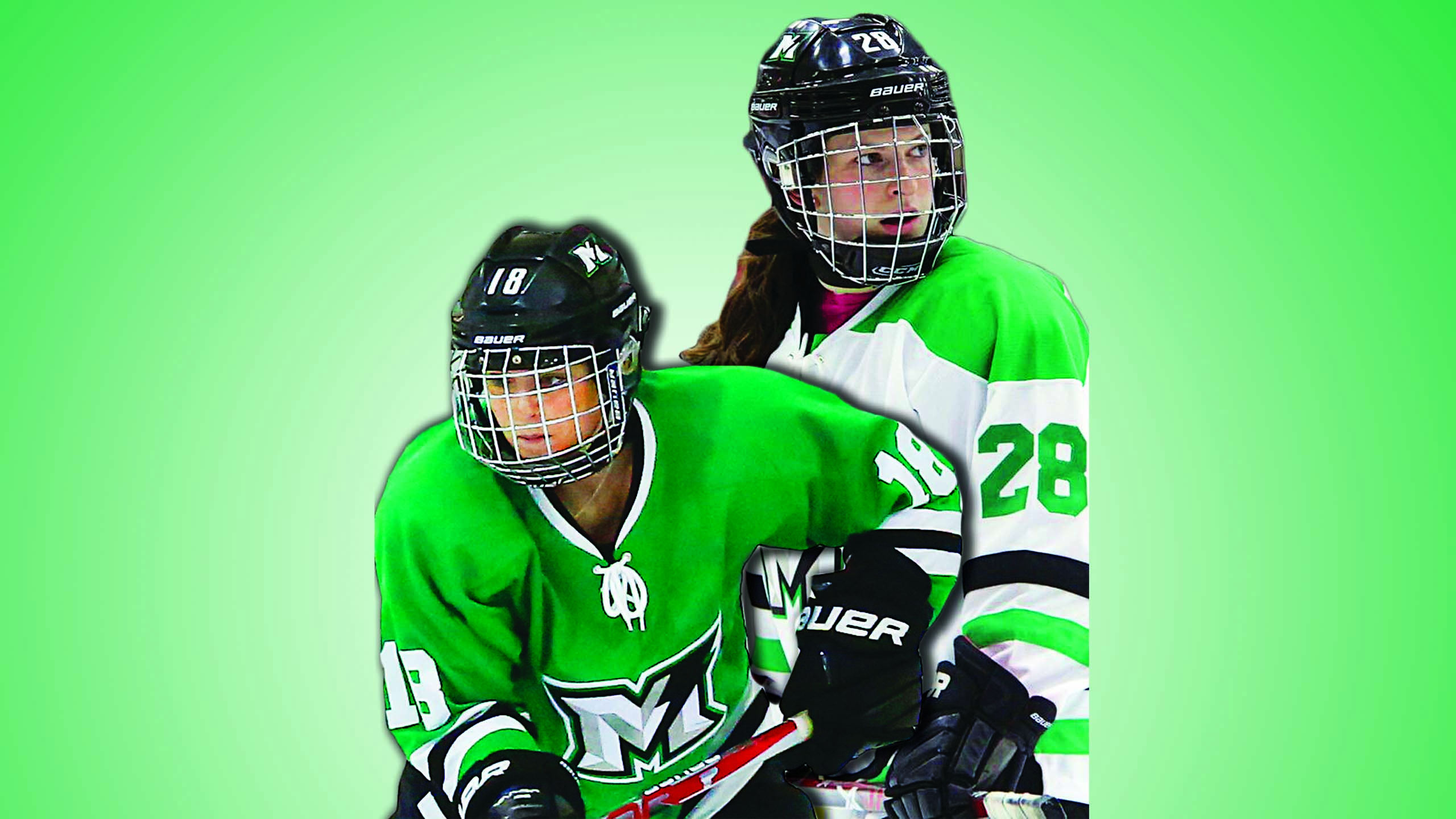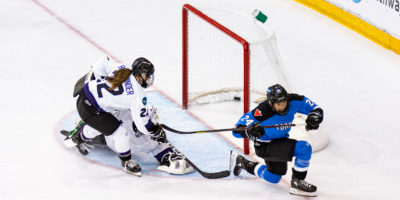By Nick Reis
Ryerson’s women’s hockey team just wrapped up its most successful season in school history—winning its first-ever playoff game in the process. The team has come a long way since its inaugural season in 2011, and Melissa Wronzberg and Jessica Hartwick would know.
They were among the first crop of recruits to suit up for head coach Lisa Haley. During the five seasons Wronzberg and Hartwick played, the Rams won just 24 games and made the playoffs only once. Both had successful individual careers—Wronzberg holds team records in points and games played, Hartwick was Ryerson’s captain—but the wins were hard to come by.
“It wasn’t always easy,” Wronzberg says. But being a trailblazer never is.
After helping to establish Ryerson’s hockey team, creating paths for more women to play university hockey, Wronzberg and Hartwick are doing the same thing at the professional level as members of the Markham Thunder, one of seven teams in the upstart Canadian Women’s Hockey League (CWHL), founded in 2007.
After graduating from Ryerson in 2015, both Wronzberg, 25 and Hartwick, 24, took a chance and chose to pursue a career playing in the CWHL. At the time, the league only consisted of five teams across Canada, and was not able to afford paying its players any sort of base salary.
As chair of of the CWHL board, Laurel Walzak always wanted to be able to pay the athletes, but was more focused on providing them with a consistent salary.
“The board from day one always wanted to be in a position to pay women, but subject to being able to pay to play where we can be sustainable long-term, and that was the key,” explains Walzak, an instructor in Ryerson’s School of Sport Media.
“I just hope women’s hockey continues to grow and players who are on the Rams now and will be in the future can do the same”
The CWHL’s founding was spearheaded by several legendary women’s hockey players, including Canadian olympians Jennifer Botterill and Sami Jo Small. Players like Marie-Philip Poulin, Hilary Knight and Caroline Ouellette have all played in the league, but despite the on-ice talent, most media have still treated the league with apathy.
The league has made innovative changes in order to grow the game of hockey. While other professional leagues like the NFL, NBA, NHL and MLB have played games overseas and toyed with the idea of international expansion, the CWHL has already established two league teams in China. “Although it does add a larger distance to travel, it has been a very unique experience to be a part of,” Hartwick says.
This past season, the initial plan was finally implemented by introducing a base stipend for every CWHL athlete, signalling a step in the right direction and bringing newfound attention to the league.
However, the pay is nothing like an NHL player’s: Each team has $100,000 to distribute among as many as 25 players each season, an average of $5,000 per player. That’s about 0.77 per cent of the lowest NHL annual salary, which is roughly $650,000.*
“The fact that I’m able to play hockey and get paid for it, that wasn’t even imaginable before. And now I’m able to live that dream,” says Wronzberg. “It’s not enough to be a living wage,” says Hartwick. “But it still helps us cover the cost of gas and equipment.”
While at Ryerson, Wronzberg and Hartwick strived to grow as athletes and as leaders in the hockey community. “I learned how to work harder, how to challenge myself, how to challenge my teammates in practice, and how to still enjoy playing even though we were losing,” Hartwick says. “There is always something to learn and take from each experience to be better next time.”
Now, both players are trying to make the game better for those who come after them, Hartwick started Hart & Stride Development Inc., a hockey development clinic that trains players of all ages and skill levels with the use of a skating treadmill, while Wronzberg works hard to be a positive role model for younger players while volunteering with community initiatives.
The league has progressed tremendously, but all progress is a joint effort of the entire league pulling together to push women’s hockey forward. “It is the effort of the athletes, the coaching staff, the board, our partners and broadcasters,” Walzak says. “To see the growth of women’s hockey [across the world], we need the support of all these various stakeholders.” The growth may seem small from the outside, but every step forward means the world to the women playing.
“Since my first season, we have had so many more people in the stands and so many more supporters on social media,” Hartwick explains.
“The fact that I’m able to play hockey and get paid for it, that wasn’t even imaginable before. And now I’m able to live that dream”
In Markham, Wronzberg and Hartwick have taken on new roles. At Ryerson, they were leaders early on.
Hartwick became Ryerson’s captain in her fourth season, and led the team to its first-ever playoff appearance that season.
“I stepped into this role very young and I admittedly think it was a big deal at first,” Hartwick says. But later on, something clicked, and Hartwick realized being a leader was much more important than she’d thought.
Meanwhile, Wronzberg has shifted from a high-scoring forward to becoming a fourth-liner, bringing the energy when her team needs it most.
With the Clarkson Cup playoffs underway, the league is getting more attention, and the Thunder are at the centre of it. Markham swept Les Canadiennes de Montreal in the semifinals to advance to the Cup finals. On March 25, they’ll take on either the Calgary Inferno or the Kunlun Red Star, one of the expansion teams based in China.
Regardless of how the season ends, Hartwick and Wronzberg are a part of something special. Although the CWHL still has hurdles to overcome, its players have bright futures. Now that they’re being paid for their work, it’s clear the league is headed in the right direction. “I think we’re still a long way from being as successful as we can be, but it’s growth and that’s all we can ask for at this point,” says Hartwick.
As the league grows, players like Wronzberg and Hartwick will be remembered. They chose to play professionally not for the money or fame, but to play a game they loved and inspire other women and girls to do the same.
“I just hope women’s hockey continues to grow and players who are on the Rams now and will be in the future can do the same,” Wronzberg says.
There is outstanding women’s hockey being played around the world at both the amateur and professional levels: it’s about time people took notice.
Correction: An earlier version of the story stated that the average NHL salary is $650,000. The Eyeopener regrets this error.










Leave a Reply